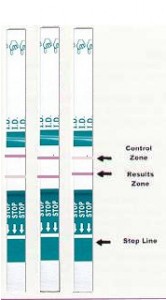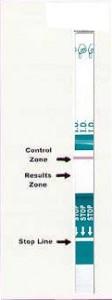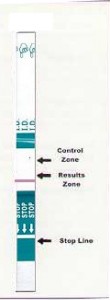The lateral flow technology (test) is also known as Immunochromatographic Technology (test). There are varieties of strips designed using lateral flow technology for detecting many analytes quantitatively in direct patient samples. A specific antibody to a specific analyte present in the sample is impregnated in the lateral flow test strip. These test strips are usually used with following samples.
- Urine
- Serum
- Whole blood
- Saliva
The lateral flow test strips are used in laboratory for screening tests. For examples detection of pregnancy; detection of infections such as malaria, avian influenza virus, HIV, syphilis etc. if the lateral flow test strips show positive result, the confirmatory tests are done to verify the disease.
The laboratory can obtain several benefits when using lateral flow test strips. It reduces the turnaround time of each test and it requires less training for operators. The production cost of the strip is low and they are simples to use simply requiring the user to place the test strip in the specimen or add specimen directly onto the strip itself and read the results after specific time.
The test strips can be stored at room temperature 18 – 20 0C in a sealed pouch until the date of expiration. These strips should be kept away from the direct sun light, moisture and heat because the moisture can harm the strip and humidity may also influence the aging and migration of the analytes. Therefore desiccant should be used to protect the strips.
Constituents of Lateral Flow Test Strip
The test strip is composed of three different materials; porous materials, reagents and housing / lamination material. The sample pad, conjugate pad, absorbent pad and membrane are all together known as porous materials. The reagents such as capture antibody, conjugate ligand, detector particles, blocking agents, detergents, surfactants, buffer and stabilizers are reagents applied over porous materials to detect the specific analyte in the specimen. The lamination / housing materials are used to protect the evaporation of reagents from the strip.
Principle of Lateral Flow Test Strip
The sample is loaded to the sample pad. The liquid fraction of the patient’s sample diffuses through the conjugate pad containing labeled detection molecules. These conjugate molecules detect the analytes of interest. The liquid fraction of sample redissolve the conjugate molecule and analytes are bound with gold conjugate and form analyte – gold conjugate complex.
The liquid fraction of the patient’s sample diffuses through the conjugate pad containing labeled detection molecules. These conjugate molecules detect the analytes of interest. The liquid fraction of sample redissolve the conjugate molecule and analytes are bound with gold conjugate and form analyte – gold conjugate complex. 
The analyte – gold conjugate complex diffuse through the membrane until meet the test line containing the specific molecules responsible for immobilizing the analyte – gold conjugate complexes. The control line where non bound conjugate particles are fixed indicating the conjugate has overflown the test line.
The absorbent pad simply collect the fluid running through the test system and prevent backflow of the fluid through the test system.
Interpretation of Test Result
The colors of the test and control line are used to read the result. The colors of the control and test line directly indicate the present of analyte in the sample.If the analyte of interest is available above the detection limit, the test line and control line are clearly visible.
If the analyte is below the detection limit, only the control line appears. This is negative result.
Other than these results are considered as invalid test results.
References
- http://microgravity.hq.nasa.gov/general_info/images/homeplanet_3.jpg
- http://www.babyhopes.com/instructions/pregstrip2.jpg




Somebody essentially assist to make critically articles I would state.
That is the very first time I frequented your web page and thus far?
I surprised with the research you made to make this particular submit incredible.
Wonderful task!
Thank you Jamel.